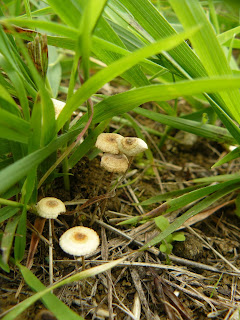Most of my data collection is concerned with what's going on above ground - which plants are growing where, and how productive they are. Although the sward is perhaps the most immediately obvious feature of a grassland, it's just the tip of the iceberg, and there's a lot of activity going on out of sight on which the familiarly green upstanding parts depend. Not only the underground parts of plants themselves, but also soil organisms work the soil like tiny miners, allowing air to flow in and water to flow out, and burying organic matter, where it is broken down by a myriad of soil fauna and flora.
One group of organisms that help tie together the above and below ground worlds are the fungi, and Autumn is when their presence is made visible to even the casual observer, as their fruiting bodies push up through turf and litter. Though the visible stage in the lifecycle is often ephemeral, fungi play a crucial role in grassland ecosystem functions: their role as decomposers is an important part of the carbon and other nutrient cycles; they themselves provide a food source for other organisms (insects, small mammals, etc); and they facilitate nutrient uptake in plant roots. Grassland fungi are vulnerable to physical and environmental disturbance, being often sensitive to such as nutrient input in the form of fertiliser, and so are declining in many semi-improved and improved grasslands.
Inspired by Sean Cooch of Natural England, and his presentation on waxcap grasslands at the Grasslands conference in August, I thought I'd see what the fungal offering was at Upper Seeds, and how many different macro fungi I could spot as I went about my other tasks on site. Apart from making a change from looking solely at forbs, it would be a useful exercise as fungi can be used as indicators of unimproved grassland quality, so the more I find of the right kind, the further the site draws away from its semi-improved past.
So, what are the right kind of fungi, that I was looking for? The best and brightest are the waxcaps (
Hygrocybe genus), that favour short swards on undisturbed, infertile soils.. Waxcaps are a group of grassland fungi known to be in serious decline, and waxcap grassland habitat is now recognised for its conservation value for mycological diversity. There's lots of information about waxcaps, their habitat and requirements on Aberystwyth University's
Waxcap Website , and English Nature's research report on waxcap grasslands can be found here:
ENRR555 Waxcap grasslands
This is a selection of the fungi I spotted in one day on site: any IDs would be very welcome, as I hesitate to even start down that road just at present (the green herbaceous things are keeping me far too busy for that!).
























































